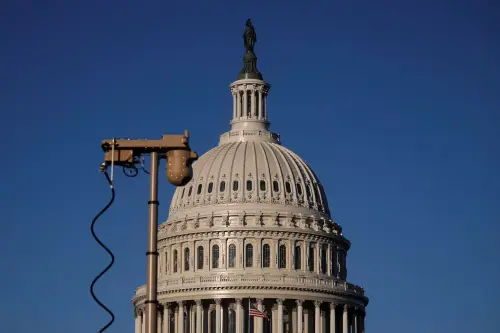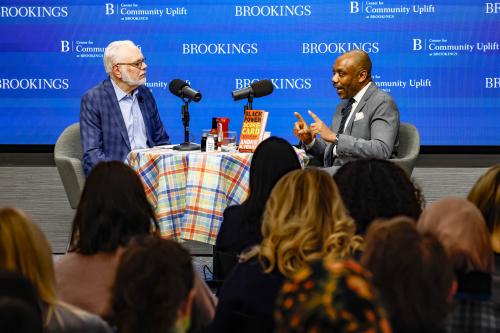Below is the first chapter from “A Better Path Forward for Criminal Justice,” a report by the Brookings-AEI Working Group on Criminal Justice Reform. You can access other chapters from the report here.
Recent incidents centering on the deaths of unarmed Black Americans including George Floyd, Daunte Wright, Elijah McClain, Breonna Taylor, William Green, and countless others have continued to apply pressure for wide sweeping police reform. To some, these incidents are the result of a few “bad apples.”1
To others, they are examples of a system imbued with institutional and cultural failures that expose civilians and police officers to harm. Our article aims to combine perspectives from across the political spectrum on sensible police reform. We focus on short-, medium-, and long-term solutions for reducing officer-involved shootings, racial disparities in use of force, mental health issues among officers, and problematic officers who rotten the tree of law enforcement.
Level Setting
Violent crime has significantly decreased since the early 1990s. However, the number of mass shootings have increased and the Federal Bureau of Investigation and the Department of Homeland Security report being worried about domestic terrorism, even within law enforcement. Nonetheless, despite recent increases that some scholars associate with COVID-19 spillovers related to high unemployment and underemployment, violent crime is still much lower than it was three decades ago.
Some scholars attribute crime reductions to increased police presence, while others highlight increases in overall levels of education and employment. In the policy space, the Anti-Drug Abuse Act of 1986 and the Violent Crime Control and Law Enforcement Act of 1994 are often noted. We believe there is some validity to all of these perspectives. For example, SWAT deployment has increased roughly 1,400 percent since 1980. Coinciding with the 1986 Drug Bill, SWAT is often deployed for drug raids and no-knock warrants.2 The death of Breonna Taylor, a 26-year-old Black woman killed in her home in Louisville, Kentucky, is most recently highlighted as an example that demonstrates some of the problems with these tactics.3
The 1994 Crime Bill ushered the COPS program and an increase in prisons around the country.4 This legislation also coincided with stop-and-frisk policies and a rise in stand-your-ground laws that disproportionately disadvantaged Black Americans and led to overpolicing. It is an indisputable fact that Black people are more likely to have force used on them. In fact, Black people relative to white people are significantly less likely to be armed or be attacking at the time they are killed by police. This is a historical pattern, including during the 1960s when civil rights leaders were being beaten and killed. However, officer-involved killings, overall, have increased significantly over the past two decades.5 And, we also know that if drugs were the only culprit, there would be drastically different outcomes for whites. Research shows that while Blacks and whites have similar rates of using drugs, and often times distributing drugs, there are huge disparities in who is arrested, incarcerated, and convicted for drug crimes. However, it is also an indisputable fact that predominately Black communities have higher levels of violent crime. Though some try to attribute higher crime in predominately Black neighborhoods to biology or culture, most scholars agree that inequitable resources related to housing, education, and employment contribute to these statistics.6 78 Research documents that after controlling for segregation and disadvantage, predominately Black and white neighborhoods differ little in violent crime rates.9
These are complex patterns, and Democrats and Republicans often differ on how America reached these outcomes and what we do about them. As a result, bipartisan police reform has largely stalled. Now, we know that in March 2021 the House of Representatives once again passed The George Floyd Justice in Policing Act. States and localities are also presenting and passing a slew of police reforms, such as in Maryland where the state legislature passed the Maryland Police Accountability Act of 2021. We are not here to debate the merits of these legislations, though we support much of the components, nor are we here to simply highlight low-hanging fruit such as banning no-knock warrants, creating national databases, or requiring body-worn cameras. People across the political aisle largely agree on these reforms. Instead, we aim to provide policy recommendations on larger-scale reforms, which scholars and practitioners across the political aisle agree needs to occur, in order to transform law enforcement in America and take us well into the twenty-first century. Our main themes include accountability, training, and culture.
Accordingly, our recommendations include:
Short-Term Reforms
- Reform Qualified Immunity
- Create National Standards for Training and De-escalation
Medium-Term Reforms
- Restructure Civilian Payouts for Police Misconduct
- Address Officer Wellness
Long-Term Reforms
- Restructure Regulations for Fraternal Order of Police Contracts
- Change Police Culture to Protect Civilians and Police
SHORT-TERM REFORMS
Reform Qualified Immunity
Qualified immunity is a legal doctrine that courts invented to make it more difficult to sue police and other government officials who have been plausibly alleged to have violated somebody’s rights.10 11We believe this doctrine needs to be removed.1213 States also have a role to play here. The Law Enforcement Bill of Rights further doubles down on a lack of accountable for bad apples.
We are not out on a limb here. A recent YouGov and Cato poll found that over 60 percent of Americans support eliminating qualified immunity.14 Over 80 percent of Americans oppose erasing historical records of officer misconduct. In this regard, most citizens have no interest making it more difficult to sue police officers, but police seem to have a very strong interest in maintaining the policy. However, not only do everyday citizens want it gone, but think tanks including The Brookings Institution and The Cato Institute have asserted the same. It is a highly problematic policy.
Though police chiefs might not say it publicly or directly, we have evidence that a significant number of them are quite frustrated by their inability to get rid of the bad apples, run their departments in ways that align with best practices they learn at Federal Law Enforcement Training Centers and National Association of Chiefs of Police, and discipline and terminate officers who deserve to be held accountable and jeopardize not only the public perception of their own department but drag down the social standing of the entire law enforcement profession. As noted above, The Law Enforcement Bill of Rights at the state level needs to be addressed. It further doubles down on qualified immunity and removes accountability for law enforcement.
National Standards for Training and De-escalation
In 2016, Daniel Shaver was fatally shot and killed by officer Philip Brailsford. Brailsford was charged but found not guilty. At the time of the killing, Shaver was unarmed as he lay dead in a hotel hallway. Police experts critiqued Brailsford’s tactics to de-escalate the situation. As he entered the scene, he had both hands on his M4 rifle and eliminated all other tools or de-escalation tactics. Brailsford was fired, tried for murder, and then rehired. He ultimately retired due to PTSD. Highlighting the roles of militarization, mental health, qualified immunity, and other policy-related topics, this incident shows why there is a need for national standards for training and de-escalation. Many officers would have approached this situation differently, suggesting there are a myriad of tactics and strategies being taught.
Nationally, officers receive about 50 hours of firearm training during the police academy. They receive less than 10 hours of de-escalation training. So, when they show up at a scene and pull their weapon, whether it be on teenagers walking down the street after playing a basketball game or someone in a hotel or even a car (like in the killing of Daunte Wright in a Minneapolis suburb), poor decisions and bad outcomes should not be surprising.
Police officers regardless of whether they live in Kentucky or Arizona need to have similar training. Among the roughly 18,000 law enforcement agencies across the country, there is wide variation in the amount of training that officers have to complete as well as what type of training they complete. With the amount of travel that Americans engage in domestically, law enforcement has not kept up to speed with ensuring that officers receive the same training. Consequently, police officers may be put in positions to make bad decisions because of a lack of the implementation of federal standards. Funding can be provided to have federally certified trainers who work with localities within states, counties, and cities.
MEDIUM-TERM REFORMS
Restructure Civilian Payouts for Police Misconduct
From 2015–2019, the 20 largest U.S. municipalities spent over $2 billion in civilian payouts for police misconduct. Rather than the police department budget, these funds mostly come from general funds.15 So, not only is the officer absolved from civil or financial culpability, but the police department often faces little financial liability. Instead, the financial burden falls onto the municipality; thus, taxpayers. This money could be going toward education, work, and infrastructure.
Not only are the financial settlement often expensive, like the $20 million awarded to William Green’s family in Prince George’s County, Maryland, but the associated legal fees and deteriorated community trust are costly. In a place like Chicago, over the past 20 years, it has spent about $700 million on civilian payouts for police misconduct. New York City spent about $300 million in the span of a few years.
We assert that civilian payouts for police misconduct must be restructured. Indemnification will be eliminated, making the officer responsible, and requiring them to purchase professional liability insurance the exact same way that other occupations such as doctors and lawyers do. This would give insurance companies a strong incentive to identify the problem officers early, to raise their rates just the way that insurance companies raise the rates on a bad driver or a doctor who engages in malpractice. In this regard, the cost of the insurance policy would increase the more misconduct an officer engaged in. Eventually, the worst officers would become uninsurable, and therefore unemployable. This would help to increase accountability. Instead of police chiefs having difficulties removing bad officers through pushback from the Fraternal Order of Police Union, bad officers would simply be unemployable by virtue of the fact that they cannot secure professional liability insurance.
Bottom line, police almost never suffer any financial consequences for their own misconduct.
Shifting civilian payouts away from tax money and to police department insurance policies would instantly change the accountability structure.
Shifting civilian payouts away from tax money and to police department insurance policies would instantly change the accountability structure. Police are almost always indemnified for that misconduct when there is a payout. And, what that means is simply that their department or the city, which is to say us, the taxpayers, end up paying those damages claims. That is absolutely the wrong way to do it.
Most proposals for restructuring civilian payouts for police misconduct have included some form of liability insurance for police departments and/or individual officers. This means shifting the burden from taxpayer dollars to police department insurance policies. If a departmental policy, the municipality should pay for that policy, but the money should come from the police department budget. Police department budget increases should take settlement costs into account and now simply allow for increased budgets to cover premium increases. This is a similar approach to healthcare providers working in a hospital. If individual officers have liability insurance, they fall right in line with other occupations that have professional liability insurance.
Congress could approve a pilot program for municipalities to explore the potential impacts of police department insurance policies versus individual officer liability insurance, and even some areas that use both policies simultaneously. Regardless, it is clear that the structure of civilian payouts for police misconduct needs to change. We believe not only will the change provide more funding for education, work, and infrastructure, but it will increase accountability and give police chiefs and municipalities the ability to rid departments of bad apples that dampen an equitable and transparent cultural environment.
Address Officer Wellness
Mental Health Counseling
In this broader discussion of policing, missing is not only the voices of law enforcement themselves, but also what is happening in their own minds and in their own bodies. Recent research has highlighted that about 80 percent of officers suffer from chronic stress. They suffer from depression, anxiety. They have relationship problems, and they get angered easily. One out of six report being suicidal. Another one out of six report substance abuse problems. Most sobering, 90 percent of them never seek help.16 We propose that officers should have mandatory mental health counseling on a quarterly basis. Normalizing mental health counseling will reduce the stigma associated with it.
It is also important for law enforcement to take a serious look into the role of far-right extremism on officer attitudes and behaviors. There is ample evidence from The Department of Homeland Security showing the pervasive ways that far-right extremists target law enforcement.17Academic research examining social dominance ideation among police officers may be a key way to root out extremism during background checks and psychological evaluations. Social dominance can be assessed through survey items and decision-making simulations, such as the virtual reality simulations conducted at the Lab for Applied Social Science Research at the University of Maryland.
Community Policing
Community police is defined in a multitude of ways. One simple way we think about community policing is whether officers experience the community in everyday life, often when they are not on duty. Do they live in the community, send their children to local schools, exercise at the neighborhood gym, and shop at the main grocery store? Often times, police officers engage in this type of community policing in predominately white and affluent neighborhoods but less in predominately Black or Latino neighborhoods, even when they have higher household income levels. Police officers also live farther away from the areas where they work. While this may be a choice for some, others simply cannot afford to live there, particularly in major cities and more expensive areas of the country. Many police officers are also working massive amounts of over time to make ends meet, provide for their families, and send children to college.
Altogether, community policing requires a set of incentives. We propose increasing the required level of education, which can justify wage increases. This can help to reduce the likelihood of police officers working a lot of hours and making poor decisions because of lack of sleep or stress. We also propose requiring that officers live within or near the municipalities where they work. Living locally can increase police-community relations and improve trust. Officers should receive rent subsidies or down payment assistance to enhance this process.
LONG-TERM REFORMS
Restructure Regulations for Fraternal Order of Police Contracts
Unions are important. However, the Fraternity Order of Police Union has become so deeply embedded in law enforcement that it obstructs the ability for equitable and transparent policing, even when interacting with police chiefs. Police union contracts need to be evaluated to ensure they do not obstruct the ability for officers who engage in misconduct to be held accountable. Making changes to the Law Enforcement Bill of Rights at the state helps with this, but the Congress should provide more regulations to help local municipalities with this process.
Change Police Culture to Protect Civilians and Police
Police have to be of the people and for the people. Often times, police officers talk about themselves as if they are detached from the community. Officers often view themselves as warriors at war with the people in the communities they serve. Police officers embody an “us versus them” perspective, rather than viewing themselves to be part of the community.18
It must be a change to police culture regarding how police officers view themselves and view others. Part of changing culture deals with transforming how productivity and awards are allocated. Police officers overwhelmingly need to make forfeitures in the form of arrests, citations, and tickets to demonstrate leadership and productivity. Police officers rarely get credit for the everyday, mundane things they do to make their communities safe and protect and serve. We believe there must be a fundamental reconceptualization of both the mission of police and the culture in which that mission is carried out. Policing can be about respecting individuals and not using force. It is an ethical approach to policing that requires incentives positive outcomes rather than deficits that rewards citations and force.
There must be a fundamental reconceptualization of both the mission of police and the culture in which that mission is carried out.
Recommendations for Future Research
First, research needs to examine how community policing and officer wellness programs can simultaneously improve outcomes for the community and law enforcement. The either/or model simply does not work any longer. Instead, research should determine what is best for local communities and improves the health and well-being of law enforcement. Second, future research on policing needs to examine the role that protests against police brutality, particularly related to Black Lives Matter protests, are having on reform at the local, state, and federal levels. It is important for policymakers to readily understand the demands of their constituents and ways to create peace and civility.
Finally, research needs to fully examine legislation to reallocate and shift funding away from and within police department budgets.19 By taking a market-driven, evidence-based approach to police funding, the same methodology can be used that will lead to different results depending on the municipality. Police department budgets should be fiscally responsible and shift funding to focusing on solving violent crime, while simultaneously reducing use of force on low-income and racial/ethnic minority communities. It is a tall order, but federal funding could be allocated to examine all of these important research endeavors. It is a must if the United States is to stay as a world leader in this space. It is clear our country is falling short at this time.
CONCLUSION
We have aimed to take a deep dive into large policy changes needed for police reform that centers around accountability, finances, culture, and communities. Though there is much discussion about reallocating police funding, we believe there should be an evidence-based, market-driven approach. While some areas may need to reallocate funding, others may need to shift funding within the department, or even take both approaches. Again, with roughly 18,000 law enforcement agencies, there is wide variation in funds provided for policing and how those funds are spent. This is why it is imperative that standards be set at the federal level to help municipalities grapple with this important issue and the others we highlight in this report.
RECOMMENDED READING
Alexander, Michelle. 2010. The New Jim Crow: Mass Incarceration in the Age of Colorblindness. The New Press.
Brooks, Rosa. 2021. Tangled Up in Blue: Policing the American City: Penguin.
Horace, Matthew. 2019. The Black and the Blue: A Cop Reveals the Crimes, Racism, and Injustice in America’s Law Enforcement. Hatchette Books.
Ray, Rashawn. “How Should We Enhance Police Accountability in the United States?” The Brookings Institution, August 25, 2020.
-
Footnotes
- Ray, Rashawn. “Bad Apples come from Rotten Trees in Policing.” The Brookings Institution. May 30, 2020. Available at: https://www.brookings.edu/blog/how-we-rise/2020/05/30/bad-apples-come-from-rotten-trees-in-policing/
- Neily, Clark. “Get a Warrant.” Cato Institute. October 27, 2020. Available at: https://www.cato.org/blog/get-warrant
- Brown, Melissa and Rashawn Ray. “Breonna Taylor, Police Brutality, and the Importance of #SayHerName.” The Brookings Institution. September 25, 2020. Available at: https://www.brookings.edu/blog/how-we-rise/2020/09/25/breonna-taylor-police-brutality-and-the-importance-of-sayhername/
- Galston, William and Rashawn Ray. “Did the 1994 Crime Bill Cause Mass Incarceration?” The Brookings Institution. August 28, 2020. Available at: https://www.brookings.edu/blog/fixgov/2020/08/28/did-the-1994-crime-bill-cause-mass-incarceration/
- Edwards, Frank, Hedwig Lee, and Michael Esposito. “Risk of Being Killed by Police Use of Force in the United States by Age, Race-Ethnicity, and Sex.” Proceedings of the National Academy of Sciences, 2019. 116(34):16793 LP – 16798.
- Peterson, Ruth D. and Lauren J. Krivo. Divergent Social Worlds: Neighborhood Crime and the Racial-Spatial Divide, 2010. New York: Russell Sage Foundation.
- Friedson, Michael and Patrick Sharkey. “Violence and Neighborhood Disadvantage after the Crime Decline,” The Annals of the American Academy of Political and Social Science, 2015. 660:1, 341–58.
- Jeffrey D. Morenoff and Robert J. Sampson. 1997. “Violent Crime and The Spatial Dynamics of Neighborhood Transition: Chicago, 1970–1990,” Social Forces 76:1, 31–64.
- Peterson, Ruth D. and Lauren J. Krivo. 2010. Divergent Social Worlds: Neighborhood Crime and the Racial-Spatial Divide, New York: Russell Sage Foundation.
- Sobel, Nathaniel. “What Is Qualified Immunity, and What Does It Have to Do With Police Reform?” Lawfare. June 6, 2020. Available at: https://www.lawfareblog.com/what-qualified-immunity-and-what-does-it-have-do-police-reform
- Schweikert, Jay. “Qualified Immunity: A Legal, Practical, and Moral Failure.” Cato Institute. September 14, 2020. Available at: https://www.cato.org/policy-analysis/qualified-immunity-legal-practical-moral-failure
- Neily, Clark. “To Make Police Accountable, End Qualified Immunity. Cato Institute. May 31, 2020. Available at: https://www.cato.org/commentary/make-police-accountable-end-qualified-immunity
- Ray, Rashawn. “How to Fix the Financial Gymnastics of Police Misconduct Settlements.” Lawfare. April 1, 2021. Available at: https://www.lawfareblog.com/how-fix-financial-gymnastics-police-misconduct-settlements
- Ekins, Emily. “Poll: 63% of Americans Favor Eliminating Qualified Immunity for Police.” Cato Institute. July 16, 2020. Available at: https://www.cato.org/survey-reports/poll-63-americans-favor-eliminating-qualified-immunity-police#introduction
- Ray, Rashawn. “Restructuring Civilian Payouts for Police Misconduct.” Sociological Forum, 2020. 35(3): 806–812.
- Ray, Rashawn. “What does the shooting of Leonard Shand tell us about the mental health of civilians and police?” The Brookings Institution. October 16, 2019. Available at: https://www.brookings.edu/blog/how-we-rise/2019/10/16/what-does-the-shooting-of-leonard-shand-tell-us-about-the-mental-health-of-civilians-and-police/
- Allen, John et al. “Preventing Targeted Violence Against Faith-Based Communities.” Homeland Security Advisory Council, U.S. Department of Homeland Security. December 17, 2019. Available at: https://www.dhs.gov/sites/default/files/publications/preventing_targeted_violence_against_faith-based_communities_subcommittee_0.pdf>.
- Ray, Rashawn, Clark Neily, and Arthur Rizer. “What Would Meaningful Police Reform Look Like?” Video, Project Sphere, Cato Institute, 2020. Available at: https://www.projectsphere.org/episode/what-would-meaningful-police-reform-look-like/
- Ray, Rashawn. “What does ‘Defund the Police’ Mean and does it have Merit?” The Brookings Institution, June 19, 2020. Available at: https://www.brookings.edu/blog/fixgov/2020/06/19/what-does-defund-the-police-mean-and-does-it-have-merit/
The Brookings Institution is committed to quality, independence, and impact.
We are supported by a diverse array of funders. In line with our values and policies, each Brookings publication represents the sole views of its author(s).





